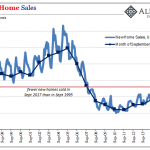As history shows, June has the lowest number of 1% declines in a second term US presidential year, as the chart to your left, courtesy Sam Stovall, illustrates quite clearly.
Although a probable Fed rate hike this summer (the betting says July over June) might be of some concern, the Nowcast data pointing to a rebounding US economy this second quarter provides the justification for a rate hike sooner rather than later.

Speaking of justifications, more and more talk and opinion supporting the exceptionally high valuation levels is heard. The anchor for this view is, of course, the three inputs into the traditional valuation model: cash flow (earnings), growth of cash flows, and the discount rate, with the main component in the discount rate being interest rates. In the bullish view, the offset to rising interest rates will be an improving outlook for earnings (cash flows). Therefore, it would be viewed by the more traditionally oriented investor that improving corporate profits with moderate levels of interest rates justify historically high P/E levels. One such argument that I have read recently suggests lowering the required return1 by 2%, which would boost justifiable P/E levels by a 50%, thereby producing a 20 P/E as a justifiable new normal level. Doing this, however, means accepting that exceptionally low interest rates are fine, even highly desirable, while ignoring the reasons WHY rates are so exceptionally low2. And this ties directly into a point I have been making for years: Is it advisable to use conventional market analysis tools in unconventional times? Given where stocks are today, apparently many think so.
Investment Strategy Implications
Equity valuation levels are high and have been so for several years running. Justifications for this are anchored in the traditional tools of economic and financial market analysis (it is what it is). The degree to which stocks can rise from current levels is hinged more on earnings (cash flow) growth than on P/E expansions (or declines in interest rates). Taken with this is the quietly improving outlook for the US economy (aided and abetted by the Fed’s exceptional degree of monetary activism) as the Nowcast data show plus the historically quiet month of June, a muted performance for stocks is the most likely scenario for the immediate future. Added to this is the market intel data that shows a global equity market environment that is in good shape (despite areas of concern), the odds favor an upward tilt (albeit modest) to stocks for the near term. All this being said, stocks remain highly vulnerable due to unforeseen (exogenous) events. In the interdependent, interconnected high speed world we live in today, shocks are more normal than they would be otherwise. Hence, the 69% net long position in the Model Growth Portfolio3.














Leave A Comment